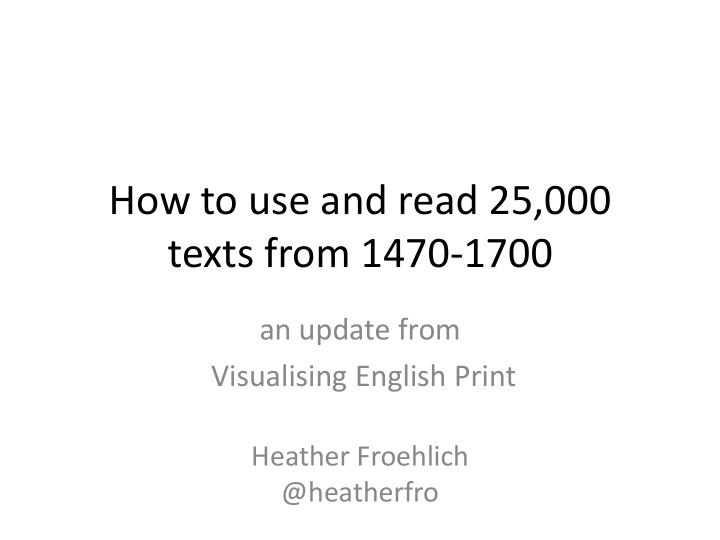



How to use and read 25,000 texts from 1470-1700 an update from Visualising English Print Heather Froehlich @heatherfro
Visualising English Print 1470-1700 • A collaborative, interdisciplinary project – University of Wisconsin-Madison – University of Strathclyde – Folger Shakespeare Library • http://vep.cs.wisc.edu/ ECRs involved 2016-2017: Eric Alexander, Deidre Stuffer, Erin Winters, Erin Larson (UWisc) Heather Froehlich, Alan Hogarth (U Strath)
“Addressing Variation at Scale in Historical Document Collections ” Eric Alexander, Deidre Stuffer and Michael Gleicher IEEE Workshop on Visualization for the Digital Humanities http://vis4dh.com
We want to to enable literature scholars to answer questions that can only be asked at scale, such as: • What were people writing about during the early modern era? • How did language and topics of discussion change over time? • Is it possible to track the evolution of particular genres? • Is our concept of “genre” itself an accurate refection of the types of works that were created? • What attributes make texts similar or dissimilar from one another?
Today’s talk: 1. Standaradise and Curate 2. Learn about the texts 3. Model stylistic difference
1. Standardise and Curate • Machine readable vs machine actionable files • TCP texts come as SGML/XML files (TEI- compliant) • Incredibly rich file format, but includes TONS of extratextual stuff
SimpleText http://graphics.cs.wisc.edu/WP/vep/simpletext/ 1. Substitutes UTF and Unicode characters for their closest counterparts in ASCII 2. It does not include any metadata annotations, favoring to store those in separate metadata- specific files 3. It does not preserve physical aspects of document layout or typography, but does strive to maintain line breaks 4. It employs simple, dictionary-based spelling standardization
Spelling Standardisation • We wanted to standardise prepositions, expand elisions, and preserve verb endings • BUT preserving Early Modern verb endings (- st , – th ) would require an overhaul of VARD’s dictionary.
WHY NOT VARD? ORIGINAL NORMALIZATION SHOULD BE all’s ell’s all’s caus’d cause caused Cicilia Cicely Cicilia courtesie curtsy courtesy diuers divers diverse hir his her ile isle I’ll ist first is’t kild kilt killed http://graphics.cs.wisc.edu/WP/vep/2015/08/25/vard-normalization-errors/
Spelling Standardisation • How to fix? – manually select some variants over others to change confidence scores – Mark non-variants and variants; input their standardised form – adding words to the dictionary – Use 1:1 dictionaries and python to modernise • ‘ heede ’ > head (unless w ‘to’: to heed) http://graphics.cs.wisc.edu/WP/vep/tag/spelling- standardization/
LOCATION IN CHARACTERS CHANGE TO WORD cyon tion End lie ly End shyp ship End t’ to_ Start th’ the_ Start tiue tive End vn un Start vs us Anywhere ynge ing End http://graphics.cs.wisc.edu/WP/vep/2015/08/24/tweaking-vard- aggressive-rules-for-early-modern-english-morphemes-and-elisions/
Some other things we changed • doe > do • bee > be • Replaced reserved XML characters (<, >, %) with at-signs (@) • Replaced ampersands (&) with the word “and” • A dash ( — ) becomes two hyphens ( – ) • TCP illegible characters (bullet: •) became carets (^) • TCP unrecognizable punctuation (small black square: ▪ ) became asterisks (*) • Replaced non-ASCII characters not assigned ASCII equivalents (e.g., pilcrow: ¶) with at signs (@) • TCP missing word symbol (lozenge in brackets: ◊ ) became ellipses in parentheses ((…)) • Deletes TCP end-of-line hyphen characters supplied during transcription (vertical bar: |, broken vertical bar: ¦) http://graphics.cs.wisc.edu/WP/vep/pipeline-2/
TEI-compliant XML vs VEP SimpleText
All files have undergone the same process build corpora
Corpora • We offer 5 collections of corpora: 1. VEP TCP Collection 2. VEP Early Modern Drama Collection 3. VEP Early Modern Science Collection 4. VEP Early Modern 1080 5. VEP Shakespeare Collection Each corpus from these collections are available in 2 forms: Unrestricted and All
VEP TCP Collection • EEBO-TCP Phase 1 corpus: 25,368 texts • ECCO-TCP corpus: 2,473 texts • EVANS-TCP corpus: 5,012 texts All of our TCP collections are available in either Standardised or Unstandardised SimpleText format. http://graphics.cs.wisc.edu/WP/vep/vep-tcp- collection/
VEP Early Modern Drama Collection • Core Drama 1660 corpus – 554 total plays; 471 unrestricted plays • Expanded Drama 1660 corpus – 666 total plays; 569 unrestricted plays • Expanded Drama 1700 corpus – 1,244 total plays; 1,009 unrestricted http://graphics.cs.wisc.edu/WP/vep/ vep-early-modern-drama-collection/
VEP Early Modern Science Collection • Super Science Corpus – 1,979 total texts; 1,130 unrestricted texts • Big Names of Science Corpus – 329 total texts; 272 unrestricted texts http://graphics.cs.wisc.edu/WP/vep/vep-early- modern-science-collection/
Early Modern 1080 Corpus • 1080 texts – Selected from EEBO-TCP phase I and ECCO-TCP – Randomly sampled at a rate of 40 texts / decade http://graphics.cs.wisc.edu/WP/vep/vep-early- modern-1080/
VEP Shakespeare Collection • Shakespeare TCP (A11954) – 36 Shakespeare plays, taken from the First Folio in from EEBO-TCP phase I (TCPID A11954) • VEP Shakespeare Folger – Our plain-text version of the Folger Digital Texts corpus http://graphics.cs.wisc.edu/WP/vep/vep- shakespeare-collection/
2. Learn about the texts • http://vep.cs.wisc.edu/metadataBuilder/ – A way of combining several different spreadsheets’ worth of metadata into ONE MEGA SPREADSHEET
Available metadata differs by corpus
Available metadata differs by corpus
3. Model Stylistic Difference http://vep.cs.wisc.edu/ubiq/
Super Science Corpus
Philosophy of Science
Thank you! http://vep.cs.wisc.edu/
Recommend
More recommend